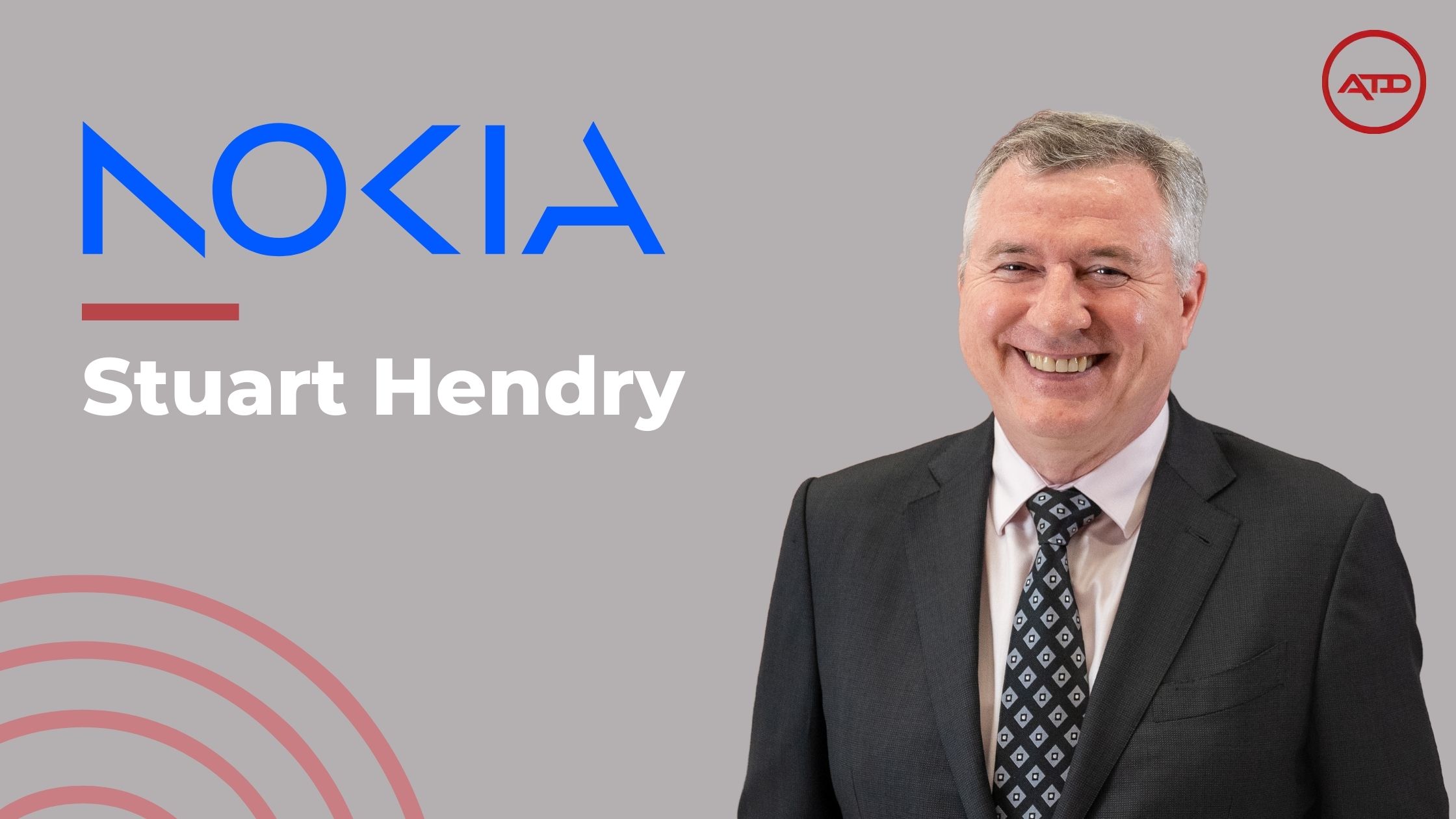AsiaTechDaily – Asia's Leading Tech and Startup Media Platform

Nokia’s Stuart Hendry Unveils EDA: The Future of Scalable, AI-Powered Data Centers in APAC
Nokia, the global tech giant, recently introduced its Event-Driven Automation (EDA) platform, a technology designed to help organizations manage the rapidly evolving demands of data center operations.
With a focus on reducing human error and downtime, EDA integrates advanced AI and Kubernetes technologies to streamline network management, predict and resolve issues proactively, and enable businesses to scale their infrastructure seamlessly. This platform is well-suited for businesses that manage complex, AI-driven environments while ensuring reliability and security across multi-cloud infrastructures.
To gain deeper insights into these developments and the broader vision for Nokia in the APAC region, we connected with Stuart Hendry, Vice President of Enterprise and Partners for Network Infrastructure at Nokia APAC.
During the interview, Stuart provided valuable insights into how Nokia’s technology is helping businesses in APAC tackle some of their most pressing challenges, from regulatory hurdles to scaling operations efficiently. He explained how EDA is a game-changer for data centers, highlighting its ability to predict and resolve issues before they affect operations.
The platform’s use of AI-driven insights, coupled with its seamless integration into cloud-native environments, allows businesses to automate and optimize their infrastructure management, driving both agility and reliability.
As the Vice President of Enterprise and Partners for Network Infrastructure at Nokia APAC, what are some of the most significant challenges you face in driving business growth across such a culturally diverse and geographically expansive region?
At Nokia, we create technology that helps the world act together.
As a B2B technology leader we often work with industry leaders and government and are early adopters on leading edge solutions throughout the world.
Our challenge as a global vendor is best to introduce these cutting-edge innovations into the APAC market and customize the local regulatory requirements. We want to enable our customers to realize their full potential and Nokia will support them by:
- Delivering resilient, superior performance across all critical parts of the network built on cutting-edge innovations and high standards of security, sustainability and ethics.
- Enabling our customers to innovate and unlock new value by connecting to ecosystems of applications and services, with next-gen networks that are AI-driven, autonomous and programmable.
- Open architectures that seamlessly integrate into any customer or partner’s ecosystem – across any server, CPU, RAN, cloud or software stack.
Nokia recently introduced its Event-Driven Automation (EDA) platform. Could you explain how this technology helps organizations address the growing demands of data center operations in the Asia-Pacific region?
One of the key strengths of EDA is its ability to adapt to fast-evolving demands by offering highly customizable automation solutions. EDA integrates with a wide range of open-source cloud-native technologies, ensuring compatibility with various tools and platforms, avoiding vendor lock-in. It includes an application store that enables users to download and quickly deploy automation tasks tailored to specific needs, speeding up solution creation and deployment. Built on Kubernetes, EDA leverages an extensive ecosystem of tools, making it easy to expand and evolve automation capabilities.
Additionally, EDA enhances cloud management by unifying the oversight of both IT and network infrastructure. It integrates seamlessly with cloud and workload management systems like OpenShift, VMware, and OpenStack, allowing real-time adaptation to changing workload and connectivity needs. EDA also simplifies multi-cloud connectivity, enabling businesses to manage workloads across private data centers and public clouds as one unified system. Furthermore, it improves operational efficiency by integrating IT service management and event notification tools like Microsoft Teams and WhatsApp to streamline network incident response and event management.
According to a study by Moody’s Ratings, the APAC data center capacity is forecasted to grow at a compound annual rate of almost 20% through 2028, with an investment of about $564 billion to meet rising computing demands. This rapid expansion projects that APAC will account for about 30% of global data center capacity, with regional capacity expected to more than double—from 10,500 MW to 24,800 MW.
This dramatic growth not only demonstrates the progress of technological innovation, but also introduces a range of complex risks and challenges for long-term operations.
One of the critical challenges we face is minimizing human error. In this complex landscape, automation has, therefore, shifted from being a luxury to an absolute necessity, ensuring operational efficiency and reducing risks associated with manual intervention. As enterprises grapple with scalability, reliability, and the need for AI-ready environments, advanced solutions like Data Center Fabric and EDA platforms are emerging as game-changers for the region’s future.
EDA promises to reduce human error and network downtime by predicting and resolving issues before they impact operations. Could you elaborate on how the platform achieves this and why it’s particularly suited to AI-driven environments?
By focusing on predictability and reliability. The platform automates the entire data center network lifecycle — from design to deployment to daily operations, assuring that changes are executed accurately and consistently. EDA eliminates the risks that arise from manual interventions and complex network management, where small errors can have significant consequences. By relying on predictable automation, the platform guarantees that only tested and proven configurations are applied, minimizing the potential for human error.
Additionally, EDA integrates AI-driven insights and real-time monitoring to predict and resolve issues before they affect operations. It continuously checks for deviations from expected network behaviors, ensuring that any discrepancies are quickly identified and corrected. This proactive approach to network management, combined with its ability to learn and adapt to evolving network conditions, makes EDA particularly suited to AI-driven environments. As AI continues to drive complex operations, having a platform that can predict and mitigate problems before they occur is essential for maintaining uptime and ensuring a smooth, efficient operation.
EDA is designed to simplify data center network operations. How does it balance speed with reliability, and what makes it stand out in comparison to other automation platforms available today?
Nokia’s EDA platform strikes a balance between speed and reliability by leveraging modern, intent-based automation built on Kubernetes. It reduces operational effort by up to 40% and mitigates human error, a major cause of network disruptions, through integrated digital twin capabilities, pre- and post-deployment checkpoints, and multi-dimensional observability. This ensures that network configurations are applied correctly and consistently, minimizing downtime and service interruptions.
What sets EDA apart from other automation platforms is its ability to integrate seamlessly into multi-vendor, multi-domain environments, offering flexibility in diverse data center infrastructures. With features like GenAI assistance, a low-code/no-code interface, and a cloud-inspired app store for customization, EDA simplifies complex network lifecycle management. The platform’s modern approach to network automation, combined with Kubernetes’ cloud-native capabilities, allows for faster, more adaptable scaling while maintaining reliability, making it particularly suited to the demands of AI-driven environments.
How does the Kubernetes platform play a role in Nokia’s EDA offering, and why is it important for network automation at scale in data centers?
Kubernetes plays a crucial role in Noka’s EDA platform by providing a reliable and flexible orchestration system for managing network automation at scale. As the leading system for managing containerized applications, Kubernetes enables EDA to bring cloud-native principles to networking, making it easier to automate data center network operations. EDA leverages Kubernetes’ API operations and ecosystem, allowing for seamless integration and management of network functions with intent-based automation. This enhances the predictability and scalability of network operations, ensuring that network configurations are applied consistently and correctly across the data center.
By utilizing Kubernetes, EDA addresses key challenges in network automation, such as integration, customization, and trust. The platform’s ability to avoid eventual consistency and ensure that networks are not left in an indeterministic state is a significant advantage.
In your view, how will AI-powered tools, like Nokia’s EDA, change the way businesses scale their infrastructure to meet the growing demands of digital services?
AI-powered tools like Nokia’s EDA will transform how businesses scale their infrastructure by providing agility without sacrificing reliability. A key challenge in traditional infrastructure management is human error, which accounts for two-thirds of outages. With EDA, instead of relying on manual interventions that increase the risk of downtime, businesses can automate their infrastructure, allowing it to evolve autonomously over time. This flexibility enables infrastructure to adapt seamlessly to changing business requirements, ensuring that the digital services can scale and evolve in parallel with the business, without compromising reliability or performance. In essence, EDA helps businesses keep their infrastructure agile and responsive.
Security is a critical concern for any data center. How does Nokia’s EDA platform address security challenges while simplifying network automation?
Nokia’s EDA platform addresses security challenges in data center networks by integrating robust, multi-layered security features that ensure protection without compromising automation or performance. In its expanded partnership with Kyndryl, Nokia’s EDA plays a critical role in securing the data center network by embedding advanced security mechanisms such as IP/Optical multi-layer security and quantum-safe networking (QSN). These capabilities provide end-to-end security for data traffic across the network, mitigating the risk of cyberattacks and ensuring compliance with industry standards.
Furthermore, the combination of Nokia’s high-performance, reliable network infrastructure with Kyndryl’s AI-powered, open-integration digital platform allows for seamless orchestration and monitoring of network activities. This integration not only simplifies automation but also enables continuous threat detection and real-time response, which is crucial for protecting sensitive data and mitigating potential vulnerabilities in complex, hybrid environments. EDA’s event-driven and AI-powered automation ensures that security protocols are dynamically updated in response to changing network conditions, thus safeguarding data center operations while reducing manual intervention and human error. By automating security processes within a unified platform, Nokia’s EDA helps enterprises modernize their infrastructure securely and efficiently, enabling them to focus on strategic growth while maintaining strong defenses against evolving cyber threats.
What role do you foresee for Nokia’s EDA in the upcoming growth of emerging Southeast Asian markets, where data center capacity is expected to increase rapidly over the next few years?
Nokia’s EDA platform is ideally positioned to support the rapid growth of data center capacity in emerging Southeast Asian markets, where demand for high-performance infrastructure is expected to surge in the coming years. Just as Nokia has partnered with Lenovo to deliver AI/ML-optimized data center solutions this October, the same principles of scalability, reliability, and automation can be applied to Southeast Asia’s burgeoning data center landscape.
As Southeast Asia continues its digital transformation, there will be an increasing need for data centers to support AI and ML, and compute-intensive workloads. Nokia’s EDA platform, with its intent-based automation and integration with existing multi-vendor environments, provides a scalable and secure foundation for managing these complex workloads. By automating network operations, EDA ensures that Southeast Asia’s data centers can scale rapidly and efficiently, meeting the demands of modern digital services without the risk of human error or operational disruptions.
EDA aims to empower IT executives to focus more on strategic work. How does the platform help businesses improve operational efficiency while allowing employees to upskill and become more agile in responding to new challenges?
Nokia’s EDA platform helps businesses improve operational efficiency by automating many of the manual, repetitive tasks that traditionally burden network teams. This automation reduces the time spent on routine network management and allows IT executives to shift their focus to more strategic initiatives, such as innovation and digital transformation. By simplifying network management through real-time data and machine learning, EDA enhances agility, enabling businesses to quickly respond to new challenges and changing market demands.
Additionally, EDA supports workforce upskilling by providing a platform that integrates with cloud-native tools like Kubernetes, making it easier for network engineers to work with modern, flexible technologies. This shift from manual configurations to automated, cloud-first solutions not only boosts operational efficiency but also helps employees become more proficient in emerging tools, ultimately creating a more skilled and agile workforce capable of tackling complex IT challenges.
Stuart emphasized the role Nokia’s EDA platform will play in supporting the rapid growth of Southeast Asia’s data center market. With capacity expected to surge in the coming years, Nokia’s solutions are designed to ensure that organizations can scale efficiently while maintaining the highest standards of security and reliability.
Through advanced automation and AI-powered insights, EDA enables businesses to adapt to the evolving demands of digital services, allowing IT teams to focus on strategic initiatives and upskill for the future of network management. As Stuart concluded, Nokia’s innovation and sustainability will continue to drive its efforts to empower businesses across the region and help them realize their full potential.



